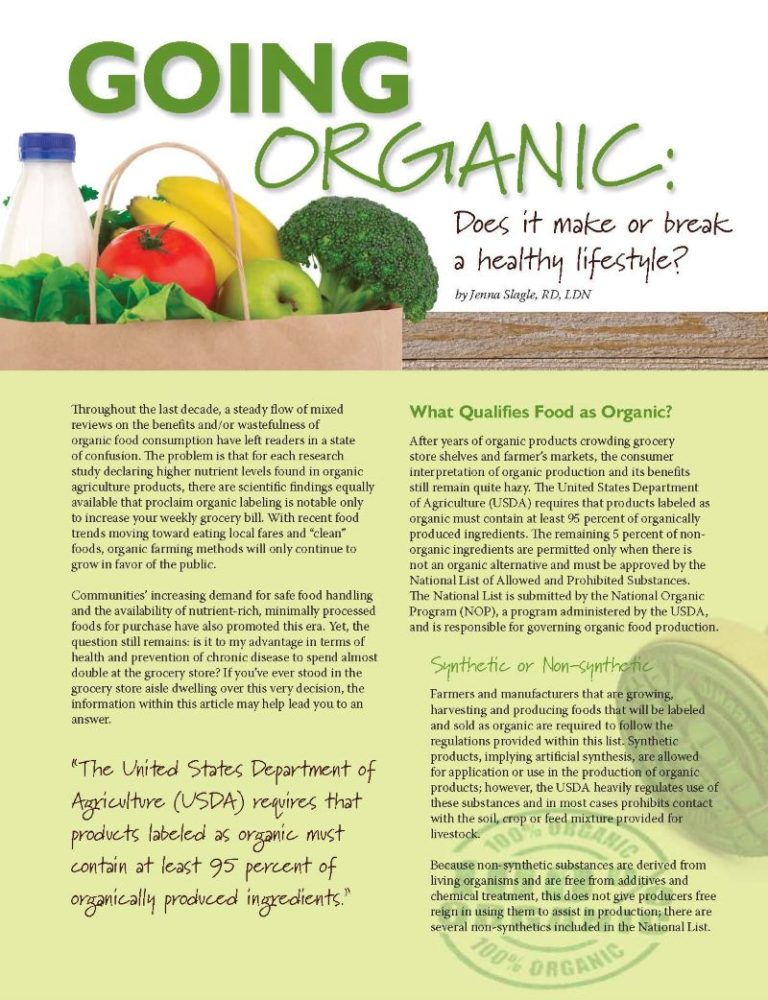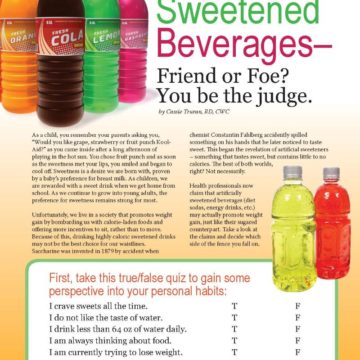Going ORGANIC: Does it make or break a healthy lifestyle?


by Jenna Slagle, RD, LDN
Fall 2011
Throughout the last decade, a steady flow of mixed reviews on the benefits and/or wastefulness of organic food consumption have left readers in a state of confusion. The problem is that for each research study declaring higher nutrient levels found in organic agriculture products, there are scientific findings equally available that proclaim organic labeling is notable only to increase your weekly grocery bill. With recent food trends moving toward eating local fares and “clean” foods, organic farming methods will only continue to grow in favor of the public.
Communities’ increasing demand for safe food handling and the availability of nutrient-rich, minimally processed foods for purchase have also promoted this era. Yet, the question still remains: is it to my advantage in terms of health and prevention of chronic disease to spend almost double at the grocery store? If you’ve ever stood in the grocery store aisle dwelling over this very decision, the information within this article may help lead you to an answer.
What Qualifies Food as Organic?
After years of organic products crowding grocery store shelves and farmer’s markets, the consumer interpretation of organic production and its benefits still remain quite hazy. The United States Department of Agriculture (USDA) requires that products labeled as organic must contain at least 95 percent of organically produced ingredients. The remaining 5 percent of non-organic ingredients are permitted only when there is not an organic alternative and must be approved by the National List of Allowed and Prohibited Substances. The National List is submitted by the National Organic Program (NOP), a program administered by the USDA, and is responsible for governing organic food production.
Synthetic or Non-synthetic
Farmers and manufacturers that are growing, harvesting and producing foods that will be labeled and sold as organic are required to follow the regulations provided within this list. Synthetic products, implying artificial synthesis, are allowed for application or use in the production of organic products; however, the USDA heavily regulates use of these substances and in most cases prohibits contact with the soil, crop or feed mixture provided for livestock.
Because non-synthetic substances are derived from living organisms and are free from additives and chemical treatment, this does not give producers free reign in using them to assist in production; there are several non-synthetics included in the National List.
While organically produced items are free from pesticides, growth hormones and antibiotics, and are regulated for synthetic and non-synthetic substances, we find that they may be more inclined to carry harmful bacteria due to improper use of manure as fertilizer. Recent repercussions of this have been seen in outbreaks of salmonella and escherichia coli by contamination of fresh organic produce.
While the NOP documents that manure must be composted and not raw when used for fertilizer, it is all but possible for the USDA to mandate all organic farm productions. Still, one must also consider the significantly fewer pesticide residues that accompany organic produce, as well as the absence of antibiotics and growth hormones in organic meat and dairy products.
Livestock
Farmers and large corporations who organically raise livestock harvested for human consumption are mandated to keep detailed records of production practices, such as feed mixtures and medicines given. Animals must also originate from land and farming techniques that have been free from prohibited practices or substances for at least three years prior to harvest, such as feeding regimens and chemicals sprayed to improve soil and pasture growth. Organic meat producers are also forbidden to feed the livestock animal by-products, manure and feed containing urea.
Organic Labeling
When purchasing processed and packaged foods claiming to be organic, it is important to note that this labeling signifies that the product contains agricultural products such as meat, poultry, eggs, grains, dairy or fresh produce that have been organically produced following USDA standards.
Products such as these are severely restricted or prohibited in the use of food additives and preservatives and should not contain substances such as monosodium glutamate, artificial sweeteners, food colorings and artificial flavorings. The 5 percent of non-organic constituents that are allowed will likely be natural additives and must continue to follow the guidelines set forth by the National List of Allowed and Prohibited Substances.
If your desires are to consume organic produce but lack the financial component, look into joining a Community Supported Agriculture (CSA) program within your area, which should be more affordable than purchasing at your local grocery store, while also supporting local farmers. Farms offer the consumer the flexibility of purchasing full shares or half shares, depending on the needs of your household. You can also opt to share with a neighbor or friend to reduce costs. Get to know your farmer and discuss production methods to ensure that the products have been organically produced. CSAs range from providing fresh produce to meat, eggs, dairy products and grains. To find a CSA near you, visit www.localharvest.org.
Should I Switch to Organic Foods?
When considering whether to go organic or not, that is lastly a decision that must be made by the consumer by weighing the pros and cons based on the resources available and prioritizing what is most important in terms of a nutritionally sound diet. If pesticide contamination or conventionally-fed livestock concerns weigh heavy, it may serve you well to purchase organically produced foods. If you choose to go the organic route, opt to purchase items that have the green and white USDA Organic label stamped on the package to ensure that the manufacturer has followed production and processing guidelines set by USDA to be certified organic.
Another option is to go organic only when purchasing produce that has been shown to contain the highest levels of pesticide residue. These foods are often termed the “dirty dozen” and include:
- peaches
- apples
- sweet bell peppers
- potatoes
- celery
- nectarines
- strawberries
- cherries
- pears
- grapes (imported)
- spinach and lettuce
Proper Food Cleaning
Always practice proper cleaning techniques at home regardless of the product purchased. Follow these quick and bacteria proof guidelines:
- Clean produce thoroughly with cold tap water.
- Remove and discard outer leaves of lettuce heads.
- Wash pre-packaged items, even if they claim to have been pre-washed.
- Scrub firm produce such as melons and potatoes with a clean scrub brush.
- Clean outer covering even if it will not be consumed: bananas, kiwis, avocados, etc.
Conclusion
Lastly, if you decide to consume conventionally produced fruits and vegetables, meats and processed products, you can rest assured that you are receiving the same nutritional benefits as the organic consumer. Although there is research supporting an increased amount of phytochemicals and trace minerals found to be in organic products, credible research findings are also available that have found non-organic products to be equally nutritious. Because the research is condescending, it’s important not to have tunnel vision, so to speak, when deciding what reviews to read.
About the Author:
Jenna Slagle, RD, LDN, is a registered and licensed dietitian working at Southern Hills Medical Center providing outpatient nutrition counseling.
by Sarah Muntel, RD Spring 2024 Spring has sprung, bringing sunnier and warmer days! For many, this…
Read Articleby Nina Crowley, PhD, RD (with Inspiration from Shawn Cochran) Winter 2024 Dating, no matter your age,…
Read ArticleWith the holidays behind us and 2022 now here, many of us are ready to tackle our…
View Video










